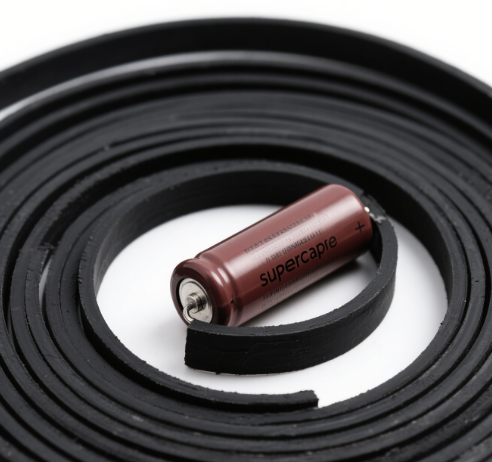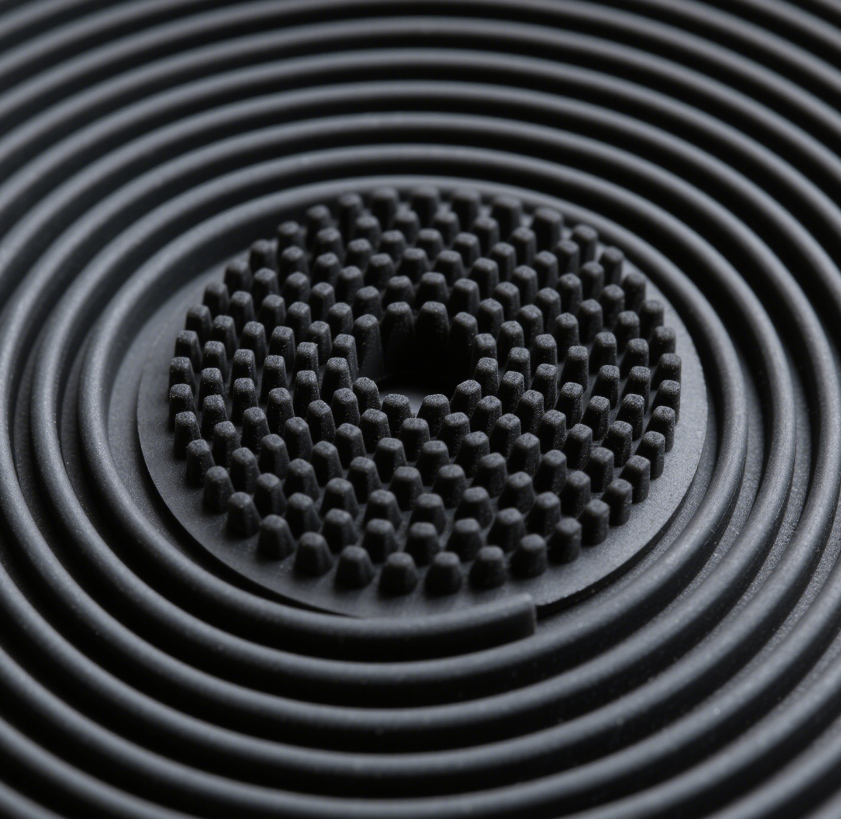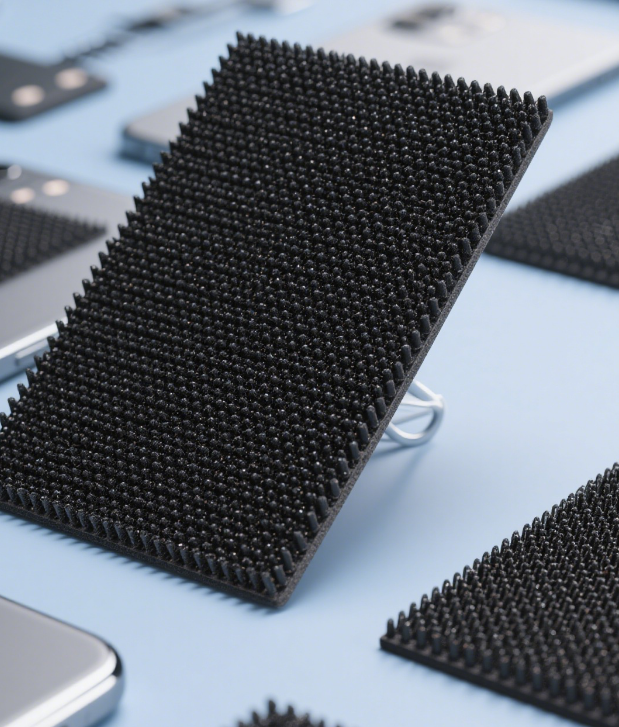silver-coated conductive rubber
Silver-coated conductive rubber is a composite material that combines the flexibility of rubber with the excellent electrical conductivity of silver by coating a silver layer on the rubber surface or embedding silver-plated fillers inside. The following is a detailed analysis from aspects such as technical principles, preparation processes, performance characteristics, application scenarios, and industry dynamics:
- Technical Principles and Structural Design
Conduction Mechanism
The electrical conductivity of silver-coated conductive rubber mainly depends on the high electrical conductivity of silver (with a resistivity of approximately 1.59×10⁻⁸ Ω·m). The silver coating achieves conductivity in the following ways:
Surface Conduction: The silver coating forms a continuous conductive path on the rubber surface, which is suitable for high-frequency electromagnetic shielding.
Filler Conduction: The rubber matrix is filled with silver-plated particles (such as silver-plated glass microspheres and silver-plated aluminum powder), and the current is conducted through the contact of the particles, which is suitable for low-frequency or static conductive scenarios.
Mixed Conduction: Combining the surface coating with the internal filler to achieve the combination of broadband electromagnetic shielding and high electrical conductivity.
Structural Design
Multilayer Structure: The bottom layer is a nickel or copper undercoat layer to enhance the adhesion between the silver coating and the rubber; the middle layer is a silver-ceramic composite layer to improve wear resistance; the surface layer is a pure silver layer to ensure high electrical conductivity.
Micro-nano Structure: Through plasma treatment or the embedding of nanosilver wires, the interfacial contact area between silver and rubber is increased, and the conductive stability is improved.
- Preparation Processes and Technical Parameters
Mainstream Preparation Methods
Electroless Silver Plating: Depositing a silver layer on the rubber surface through an oxidation-reduction reaction. The process is simple, but the thickness uniformity is poor.
Electroplating Silver: Forming a dense silver layer through electrolytic deposition. The thickness is controllable (5-50μm), but cyanide electrolytes need to be used, resulting in high environmental protection costs.
Spraying Silver Paste: Mixing silver powder with resin and then spraying. It is suitable for complex shapes, but the adhesion is weak.
Solid-state Deposition Technology: As described in Abstract 16, using a supersonic airflow to impact silver powder onto the rubber surface to form a metallurgical bond. The coating thickness can reach 4mm, and the adhesion is >30MPa.
Key Process Parameters
Surface Treatment: Sandblasting treatment makes the surface roughness of the rubber reach Ry60-180μm to enhance the adhesion of the silver coating.
Deposition Conditions: The working gas temperature is 200-800°C, the pressure is 0.5-3.5MPa, and the distance between the spray gun and the surface is 3-35mm to ensure uniform deposition of silver powder.
Post-treatment: Polishing or machining reduces the surface roughness to Ra≤0.8μm to improve the electrical conductivity.
III. Performance Characteristics and Technical Indicators
Electrical Conductivity
Volume Resistivity: For rubber with a pure silver coating, it can reach 0.004 Ω·cm, and for rubber with silver-plated fillers, it is 0.008-0.1 Ω·cm.
Shielding Effectiveness: It can reach 120 dB at 10 GHz, meeting the requirements of the US military standard MIL-G-83528.
Mechanical Properties
Hardness: Shore A hardness is 30-60 degrees, tensile strength ≥1.38 MPa, and elongation ≥100%.
Corrosion Resistance: There is no obvious corrosion in the salt spray test (5% NaCl, 96h), and it does not change color when exposed to sulfides (immersed in 1% Na₂S for 30min).
Environmental Adaptability
Operating Temperature: -55°C to 220°C, and some models (such as silver-glass rubber) can withstand a high temperature of 250°C.
Moisture and Heat Resistance: In an environment of 85°C/85% RH, the change rate of volume resistivity is <10%.
- Application Areas and Typical Cases
Electronics and Communication
Electromagnetic Shielding: Used as conductive sealing gaskets for 5G base stations and server cabinets to suppress electromagnetic wave interference.
Flexible Circuits: Silver-coated silicone rubber is used as flexible electrodes for wearable devices, with stable electrical conductivity.
Aerospace
Antistatic Materials: Conductive sealing rings for aircraft fuel systems to prevent explosions caused by static electricity accumulation.
High-frequency Devices: Conductive rubber connectors for satellite communication antennas to meet the requirements of lightweight and high reliability.
Automotive Industry
Battery Management System: Conductive seals for battery packs of new energy vehicles to ensure electrical connection and waterproof performance.
Sensors: Conductive rubber supports for vehicle-mounted radars, which have both electrical conductivity and shock absorption functions.
Medical Equipment
Electrode Materials: Conductive rubber sheets for ECG electrodes, with excellent electrical conductivity and good biocompatibility.
Surgical Instruments: Corrosion-resistant silver-coated rubber is used for endoscope seals to reduce the risk of infection.
- Technical Challenges and Solutions
Oxidation Problem
Cause: Silver is easily oxidized to form Ag₂O in a humid environment, leading to an increase in resistivity.
Solutions:
Coating an anti-oxidation coating on the surface (such as polyimide).
Adding an antioxidant (such as gallic acid) to inhibit the oxidation reaction.
Insufficient Adhesion
Cause: The interfacial bonding force between silver and rubber is weak, and it is easy to fall off.
Solutions:
Activating the rubber surface through plasma treatment to form a micro-nano structure.
Using a nickel or copper undercoat layer to enhance the interfacial bonding.
Cost Control
Cause: Silver is a precious metal, and the cost accounts for a high proportion.
Solutions:
Using silver-copper alloys or silver-plated glass microspheres to replace pure silver.
Optimizing the coating thickness to reduce the amount of silver used while ensuring performance.
- Market Dynamics and Development Trends
Market Size
In 2025, the global market size of conductive silver adhesives is expected to exceed 10 billion US dollars, of which silver-coated conductive rubber accounts for approximately 15%.
The Chinese market has the fastest growth rate. The market size of conductive silver adhesives in China reached 15 billion yuan in 2024 and is expected to exceed 30 billion yuan in 2030.
Technical Trends
Nanostructuring: Combining nanosilver wires with graphene to improve electrical conductivity and mechanical strength.
Environmental Protection: Green processes such as cyanide-free electroplating and water-based silver paste gradually replace traditional technologies.
Multifunctionalization: Integrating functions such as heat conduction, antibacterial properties, and self-healing to expand application scenarios.

















